1993 CHEVROLET CAVALIER spare tire
[x] Cancel search: spare tirePage 165 of 308

Downloaded from www.Manualslib.com manuals search engine Part 5
Problems on the Road
Hazard Warning Flashers .......................................... .164
Towing Your Chevrolet ........................................... .169
Engine Overheating
.............................................. ,174
If a Tire Goes Flat ............................................... .184
ComDact Spare Tire
.............................................. .191
Jumpstarting
....................................................164
ChangingaFlatTire .............................................. 184
If You’re
Stuck: In Sand, Mud, Ice or Snow ................... ...... .192
Here you’ll find what to do about
some problems that can occur on
the road.
I63
Page 188 of 308
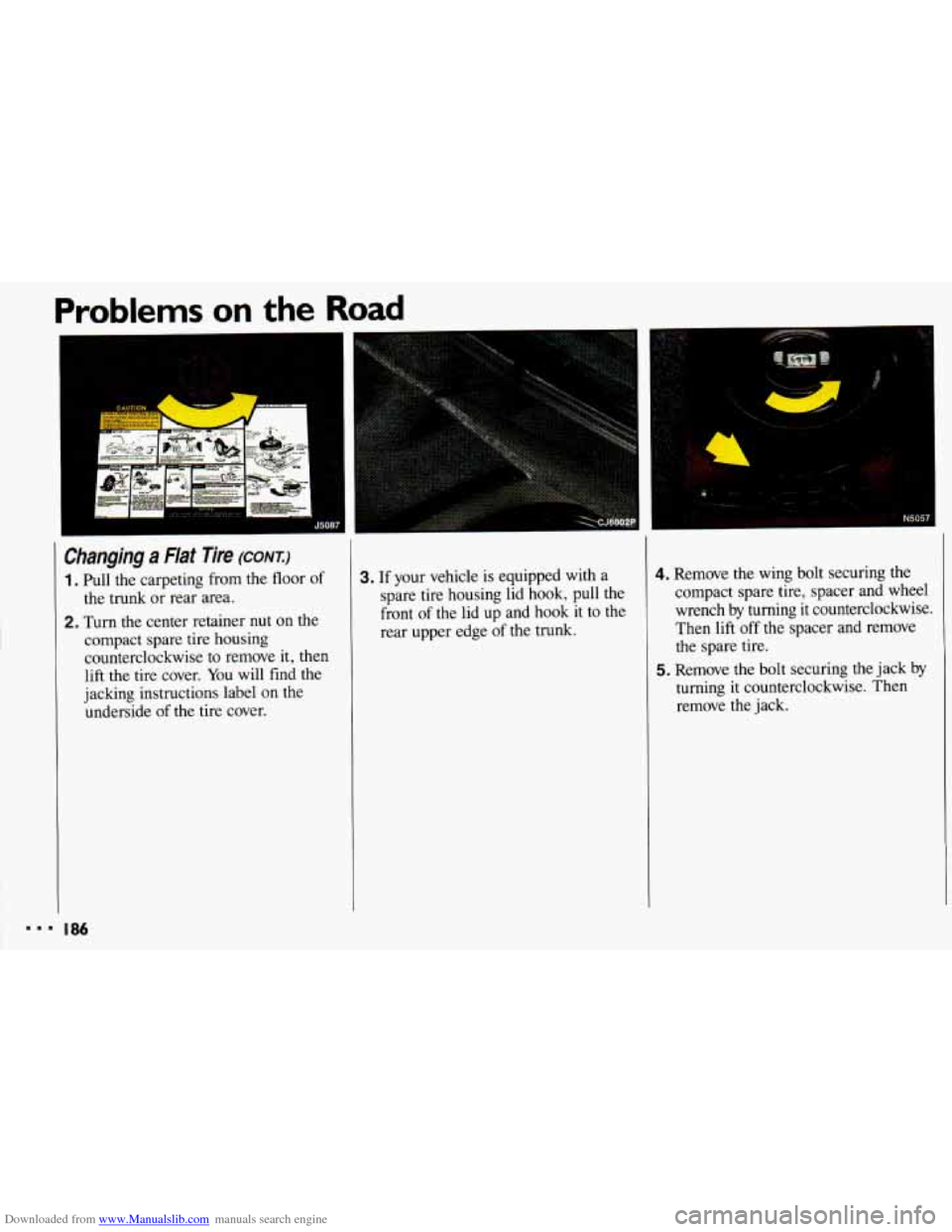
Downloaded from www.Manualslib.com manuals search engine Problems on the R
Changing a Flat Tire (CONT:)
1 . Pull the carpeting from the floor of
2. Turn the center retainer nut on the
the trunk
or rear area.
compact spare tire housing
counterclockwise to remove it, then
lift the tire cover. You will find the
jacking instructions label on the underside
of the tire cover.
3. If your vehicle is equipped with a spare tire housing lid hook, pull the
front
of the lid up and hook it to the
rear upper edge of the trunk.
4. Remove the wing bolt securing the
compact spare tire, spacer and wheel
wrench
by turning it counterclockwise.
Then lift
off the spacer and remove
the spare tire.
5. Remove the bolt securing the jack by
turning it counterclockwise. Then
remove the jack.
... I a6
Page 190 of 308

Downloaded from www.Manualslib.com manuals search engine Problems on the Road
Changing a Flat Tire (CONT.)
8. Position the jack under the vehicle.
Raise the jack head until it fits firmly
into the notch
in the vehicle’s frame
nearest the flat tire.
Do not raise the
vehicle yet. Put the compact spare
tire near you. Raising your vehicle with
the jack
improperly positioned will damage
the vehicle or may allow the
vehicle to fall off
the jack. Be sure
to fit the jack lift head into the
proper location before raising your
vehicle.
Getting under a vehicle when
it is jacked
up is dangerous. If I II NOTICE the vehicie slips off the jack, you I could be badly injured or killed.
Never get under
a vehicle when it
is supported only by a jack.
I88
9. Raise the vehicle by rotating the
wheel wrench clockwise. Raise the
vehicle far enough off the ground
so
there is enough room for the spare
tire
to fit.
1 0. Remove all of the wheel nuts and, if
you have a wheel cover, use your
fingers to carefully pry the wheel
cover from the wheel. Then
take off
the flat tire.
Page 193 of 308
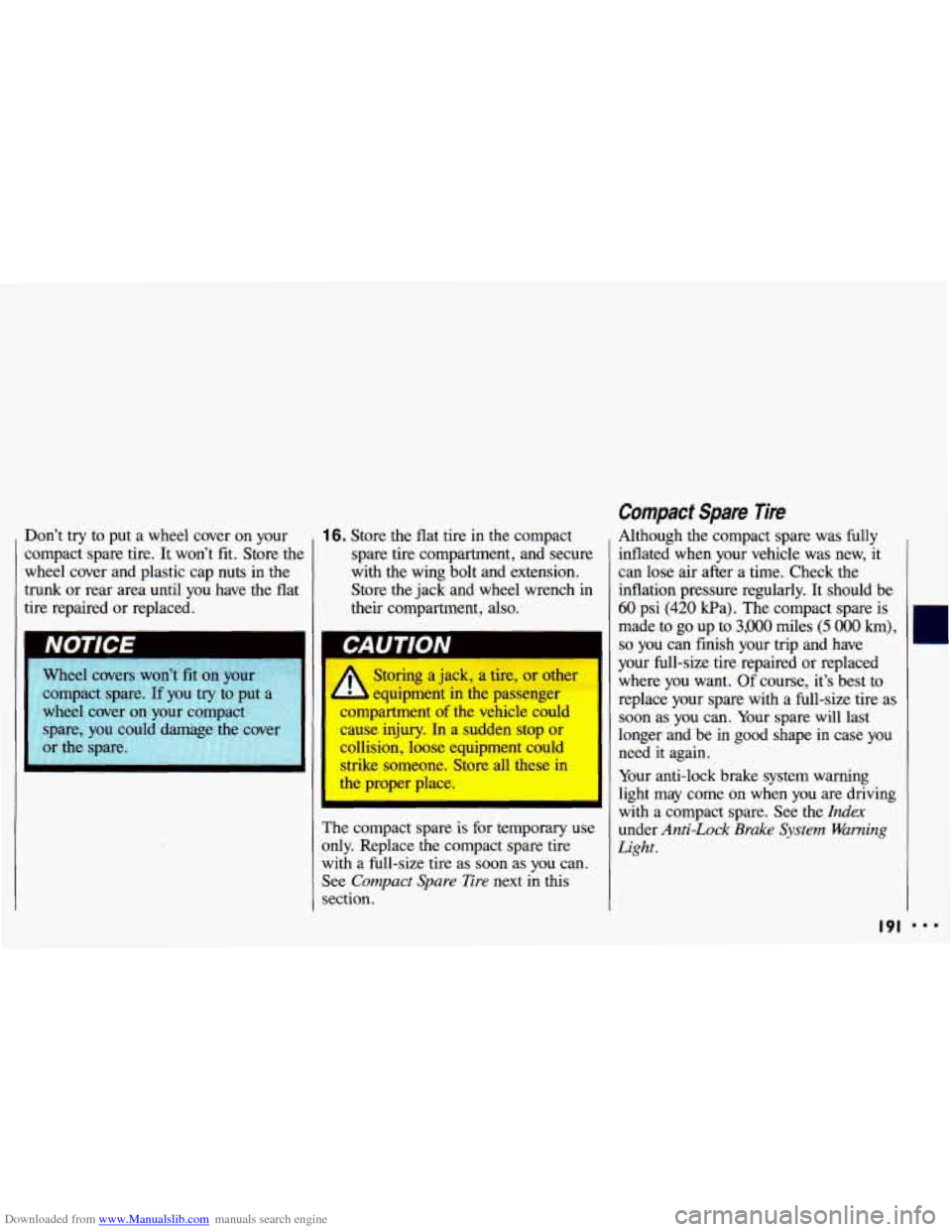
Downloaded from www.Manualslib.com manuals search engine Don’t try to put a wheel cover on your
compact spare tire.
It won’t fit. Store the
wheel cover and plastic cap nuts in the
trunk or rear area until you have the flat
tire repaired or replaced.
16. Store the flat tire in the compact
spare tire compartment, and secure
with the wing bolt and extension.
Store the jack and wheel wrench in
their compartment, also.
MU I IVN 1
Storing a jack, a tire, or other
:quipment in the passenger
compartment
of the vehicle could
cause injury. In a sudden stop
or
collision, loose equipment could
strike someone. Store all these in
the proper place.
The compact spare is for temporary use
only. Replace the compact spare tire
with a full-size tire as soon as you can.
See
Compact Spare Tire next in this
section.
Compact Spare Tire
Although the compact spare was fully
inflated when your vehicle was new, it
can lose air after a time. Check the
inflation pressure regularly.
It should be
60 psi (420 Wa). The compact spare is
made to go up to
3,000 miles (5 000 km),
so you can finish your trip and have
your full-size tire repaired or replaced
where you want.
Of course, it’s best to
replace
your spare with a full-size tire as
soon as you can. Your spare will last
longer and be in good shape in case you
need it again.
Your anti-lock brake system warning
light may come on when you are driving
with a compact spare. See the
Index
under Anti-Lock Brake System Warning
Light.
191
Page 194 of 308
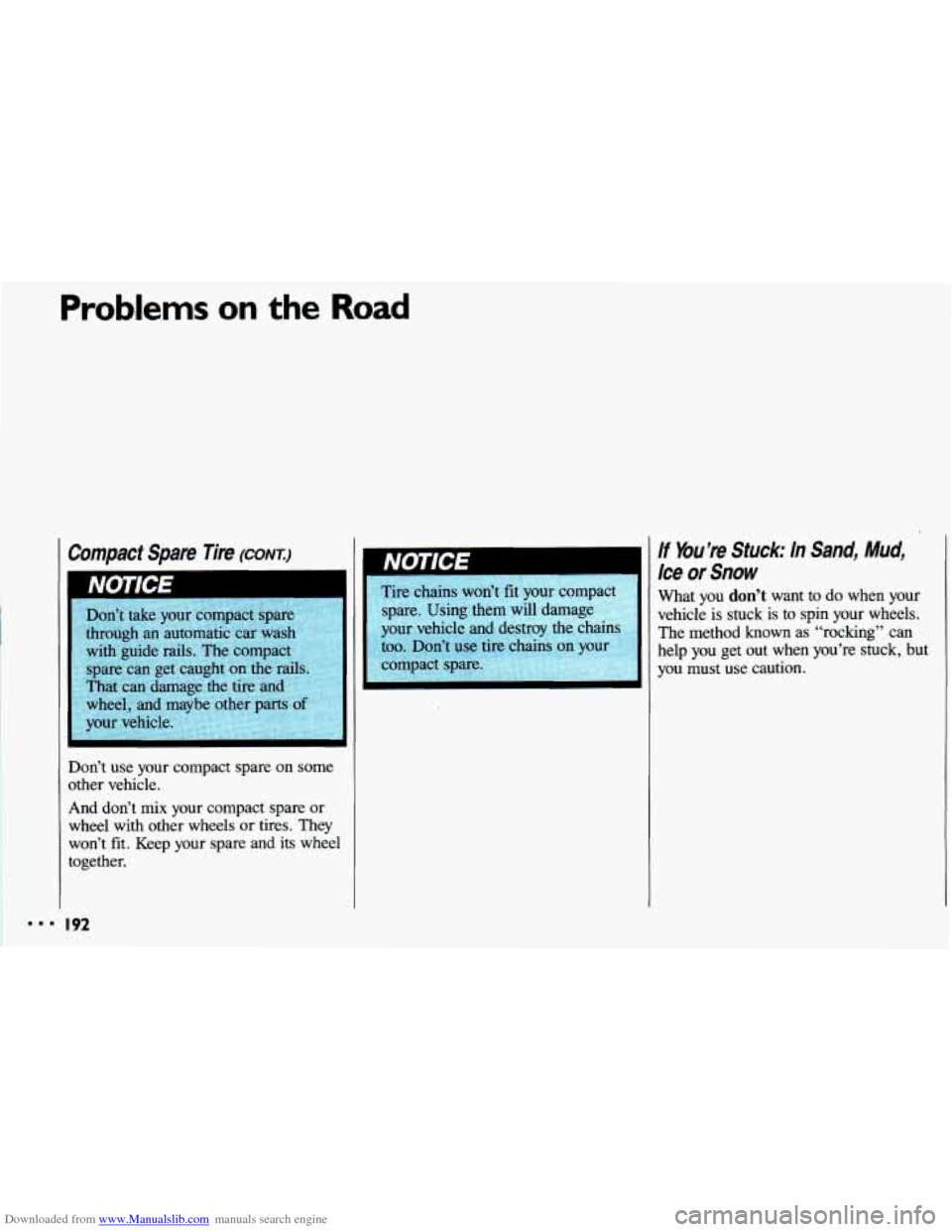
Downloaded from www.Manualslib.com manuals search engine Problems on the Road
Compact Spare Tire (CONT.)
Don't use your compact spare on some
other vehicle.
And don't
mix your compact spare or
wheel with other wheels or tires. They
won't fit. Keep your spare and its wheel
together.
I92
Tire spare. chains Using won't them=! fit your compact ;$
your vehicle and destroy the chains""'"
too. Don't use tire chains on your
compact spare.
lf You're Stuck: In Sand, Mud,
lce or Snow
What you don't want to do when your
vehicle is stuck is to spin your wheels.
The method known as "rocking" can
help 'you get out when you're stuck, but
you must use caution.
Page 231 of 308

Downloaded from www.Manualslib.com manuals search engine 1--
-
Things you=
strike and injure
people in
a sudden stop or turn, or
in
a crash.
Put things in the trunk or rear
area
of your vehicle. In a trunk,
put them as hr forward as you
can.
Try to spread the weight
evenly.
If you have fold-down
rear seats, you’ll find four
anchors on the back wall
of your
trunk.
You can use these anchors
to tie down lighter loads. They’re
not strong enough for
heavy
things, however, so put them as
fbr forward
as you can in the
trunk or rear area.
Never stack heavier things, like
suitcases, inside the vehicle
so
that some of them are above the
tops
of the seats.
e When you carry something
inside the vehicle, secure it
whenever you can.
unless you need to.
0 Don’t leave a seat folded down
I
Tires
We don’t make tires. Your new vehicle comes with high quality tires made by a
leading tire manufacturer. These tires are warranted by the tire manufacturers and
their warranties are delivered with every
new Chevrolet. If your spare tire is a
different brand than your road tires,
you will have a tire warranty folder from each
of these manufacturers.
I I
CAUTION
Poorly maintained and improperly used tires are dangerous. 1
’ - Overloading your tires can cause overheating as a result of too much
friction. You could have
an air-out and a serious accident. See the Index
under hading Your Vehicle.
Underinflated tires pose the same danger as overloaded tires. The resulting
accident could cause serious injury. Check all tires frequently to maintain
the recommended pressure. Tire pressure should be checked
when your
tires
are cold.
sudden impact:
such as when you hit a pothole. Keep tires at the
recommended pressure.
I Overinflated tires are more likely to be cut, punctured, or broken by a
Worn, old tires can cause accidents. If your tread is badly worn, or if your
I tires have been damaged, replace them. I
229
I
I..
Page 232 of 308
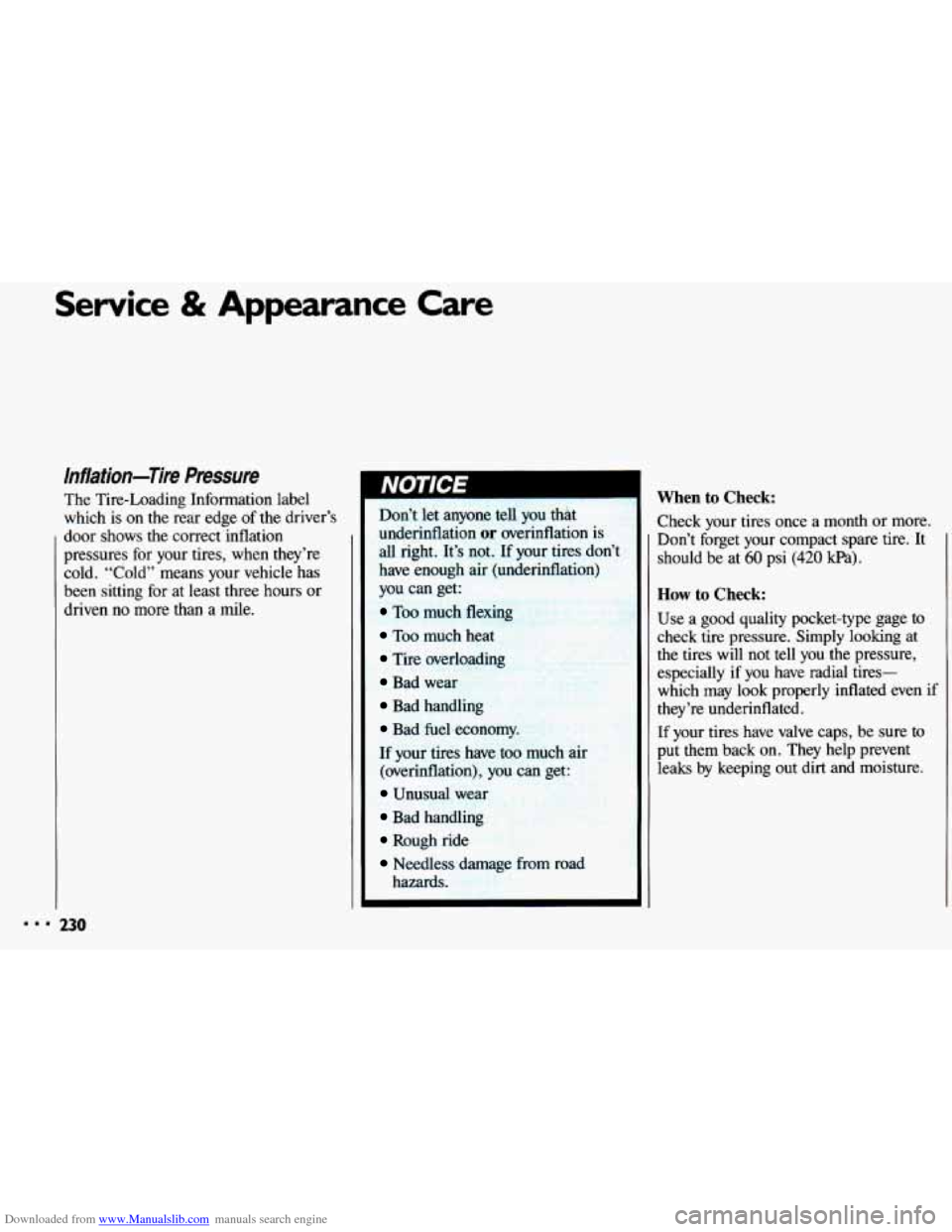
Downloaded from www.Manualslib.com manuals search engine Service & Appearance Care
lnflation-lire Pressure
The Tire-Loading Information label
which is
on the rear edge of the driver’s
door shows the correct inflation
pressures for your tires, when they’re
cold. “Cold” means your vehicle has
been sitting for at least three hours or
driven no more than a mile. Don’t
let anyone tell you that
underinflation
or overinflation is
all right. It’s
not. If your tires don’t
have enough
you can get:
Too much flexing
Too much heat
Tire overloading
Bad weLA
Bad handling
Bad fuel economy. ition)
If your tires have too much air
(overinflation), you can get:
Unusual wear
Bad handling
Rough ride
Needless damage from road
hazards.
When to Check:
Check your tires once a month or more.
Don’t forget your compact spare tire. It
should be at
60 psi (420 kpa).
How to Check:
Use a good quality pocket-type gage to
check tire pressure. Simply looking at
the tires will not tell you the pressure,
especially if
you have radial tires-
which may look properly inflated even if
they’re underinflated.
If your tires have valve caps, be sure to
put them back on. They help prevent
leaks by keeping out dirt and moisture.
230
Page 234 of 308
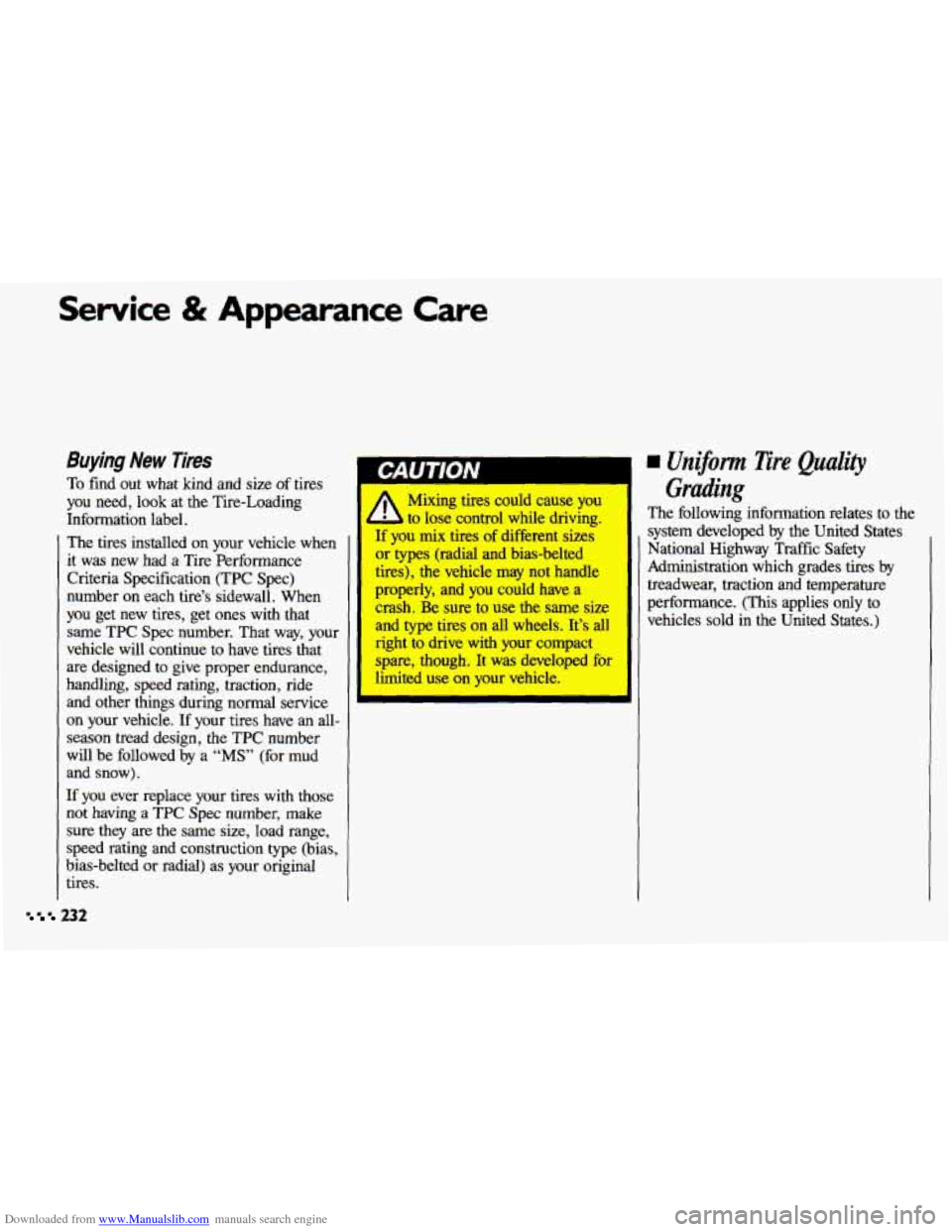
Downloaded from www.Manualslib.com manuals search engine Service & Appearance Care
Buying New Tires
To find out what kind and size of tires
you need, look at the Tire-Loading
Information label.
The tires installed on your vehicle when
it was new had a Tire Performance
Criteria Specification (TPC Spec)
number on each tire’s sidewall. When
you get new tires, get ones with that
same
TPC Spec number. That way, your
vehicle will continue to have tires that are designed to give proper endurance,
handling, speed rating, traction, ride
and other things during normal service
on your vehicle. If your tires have an all- season tread design, the TPC number
will be followed by a
“MS” (for mud
and snow).
If you ever replace your tires with those
not having a TPC Spec number, make
sure they are the same size, load range,
speed rating and construction type (bias,
bias-belted or radial) as your original
tires.
Mixing tires could cau’se you
d to lose control while driving.
If you mix tires of different sizes
or types (radial and bias-belted
tires), the vehicle
may not handle
properly,
and you could have a
crash. Be sure to use the same size
and type tires on all wheels. It’s all
right to drive with your compact
spare, though. It was developed for
limited use on your vehicle.
I I
Unijiorpn Tire Quality
Grading
The following information relates to the
system developed by the United States
National Highway Traffic Safety
Administration which grades tires by
treadwear, traction and temperature
performance. (This applies only to vehicles sold in the United States.)
232